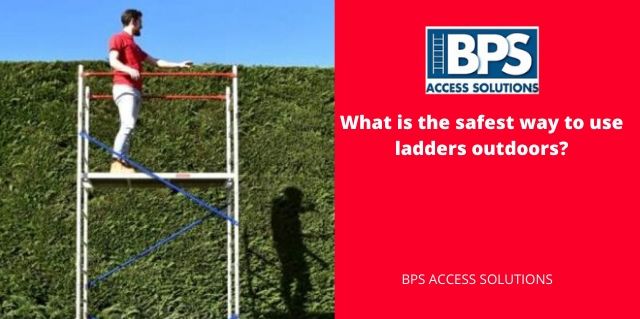Every day ladders are used in all sorts of different environments to carry out all sorts of
different tasks. That’s why there are so many different types of ladder out there. As a result,
there are lots of different ways to use a ladder, both indoors and outdoors. However,
regardless of where you’re using a ladder, you always need to keep safety as your number
one priority.
Working at height can be very dangerous, even if you’re only working a metre or two off the
ground. Falls from height are one of the top causes of serious injury and death at work,
despite rigorous regulation and safety precautions. In this article we’ll discuss ladder safety,
specifically ladder safety in outdoor environments. Ladder safety is just as important
indoors, but generally people are more familiar with indoor environments and there are
fewer hazards which could result in an accident.
What types of ladder can be used outdoors?
While there’s no specific type of ladder which can or can’t be used outdoors, there are
certain types of ladder which are more suitable for outdoor use, just like there are certain
types of ladder which are more suitable for indoor use. Generally speaking, step ladders are
more suited to indoor use because they have four legs and therefore require a more level
surface to stand upon safely.
By comparison, two legged ladders require a smaller area of ground to be set up. They also
rest against other structures to stay upright, meaning there is less risk of losing balance, as
long as the user follows working guidelines.
What are the risks when using a ladder outdoors?
Outdoor work environments come with significantly more hazards when it comes to setting
up and using a ladder, or most other types of equipment for that matter. Whereas the
environment indoors is usually controlled and protected from the elements, outdoor
environments are quite the opposite. There are a number of potential risk factors which can
be hard to control. For example, the weather could quickly turn and unleash a burst of
torrential rain or strong gusts of wind. This would immediately make a ladder a hazardous to
be working on and would require the user cease work temporarily.
The second, and perhaps more relevant hazard, which is generally a bigger concern when
working outdoors, is the ground surface. Indoor floors tend to be more even, whereas
outdoors there is a much higher chance of uneven ground. What’s more, the ground surface
itself may be soft and could give way under the weight of a ladder when in use.
Finally, there is also a higher risk of hazards caused by other activities, whether they are on
the same worksite or outside of the worksite altogether. For example, there many be other
moving machinery or hazards like overhead power lines which could easily cause a serious
accident if something went wrong.
What should you do to mitigate these risks when using a ladder outside?
Although using a ladder outdoors does come with more safety risks, there are a number of
precautions you can take to ensure that the process is as safe as possible. These precautions
generally apply to both two-legged and four-legged ladders. Firstly, alongside checking the
ladders are in good working order, you should check to see if there is set to be any bad or
rapidly changing weather. As previously mentioned, rain or strong winds can be a serious
hazard for anyone working on a ladder, but a quick check beforehand could make all the
difference.
If the weather is acceptable, you also need to prepare the ground to set up your ladder.
Ensure that there are no holes where you will be carrying out work and make sure the floor
surface is flat. If you need to set up a ladder on grass, for example, you can lay down a board
or mat to spread the weight of the ladder and reduce the likelihood of it sinking into the
ground. Workers should also be wearing the appropriate safety gear, including hard hats, to
further reduce the risk of injury. Finally, if you are using a two-legged ladder, you should
consider tying it to the structure you are leaning it against just to reduce the risk of slipping
when in use.
All things considered, using a ladder outdoors isn’t too different to using a ladder indoors.
You just need to take some extra precautions to ensure the work environment and ladder
set up is safe for whoever is going to use it.
If you would like to know more about any of the ladders or other height access equipment
we stock, please get in touch with our expert team. They have many years’ experience
supplying ladders to professional users across the UK.
No related posts.



